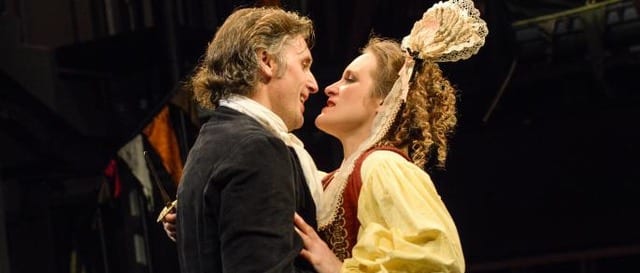The Double Dealer is one of those plays that you rarely have the chance to see on stage. Written in 1693 by William Congreve, it is indeed rarely performed in London and even though it has moments of great wit, as a whole it lacks power compared to other Restoration Comedies.
Congreve preserves the three unities of time, place, and action by writing an almost 3-hour long evening where everything runs in real-time and where couples swap partners, people fall in love with the wrong partners, relatives plot against each other, and overall cause lots of jealousy, machiavellian scheming and tension!

Director Selina Cadell has put together a talented ensemble of performers who bring to life this Restoration piece and provide moments of mirth. Jenny Rainsford stands out as Lady Plyant, as well as Jonathan Broadbent as Brisk – both of who provide excellent highlights of laughter with their fast-paced dynamic speeches and physicality. The elaborate costumes, the fans, the letters, and the confusion, create a lively atmosphere and an enjoyable evening but the production’s energy drops soon after the first hour. It is interesting seeing characters existing through language, and humour through wordplay rather than slapstick. Overall, though, the production suffers from too much unnecessary movement – perhaps too many bows and spins – as well as a design which did not rise above expectations.
One of the most positive elements of the production was the excellent relationship between audience and ensemble. The auditorium and the stage often share the same light, allowing the actors to connect and play with members of the audience. There is never a fourth wall, and the ensemble very successfully manages to involve the audience in every single moment. The intimate in-the-round auditorium of the Orange Tree Theatre is a perfect space for this effect, allowing the audience to feel part of Lord Touchwood’s residence throughout.
The production’s score – adapted from the score that Henry Purcell wrote for the original production of the play in 1693 – was beautiful, despite the fact that the live cello was only seen once and for a short scene.
This is a production which is well-realised and enjoyable, but at times quite unremarkable and lesser of its potential.

